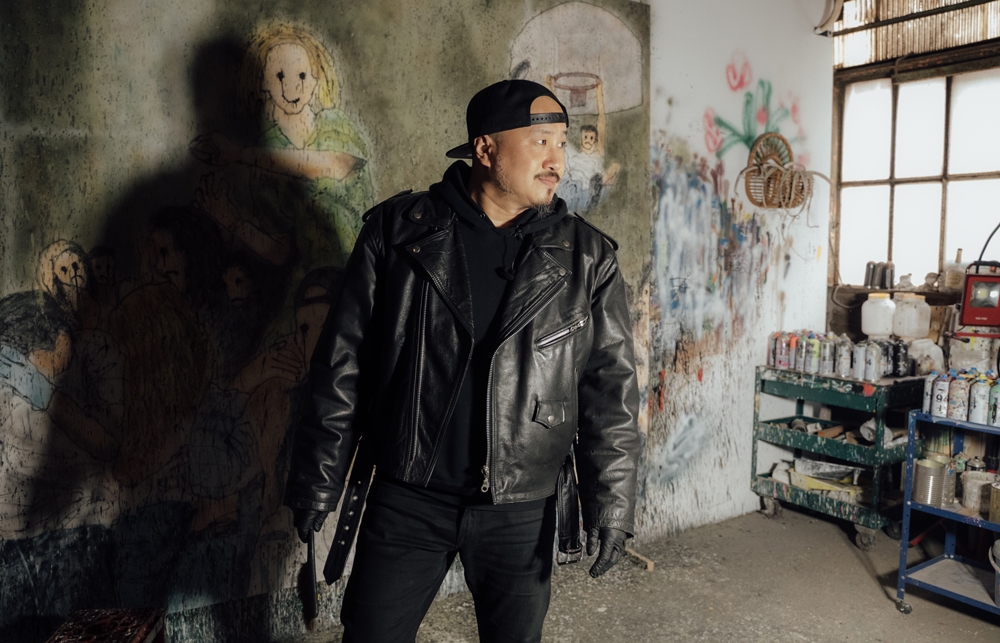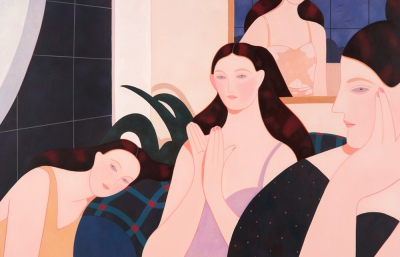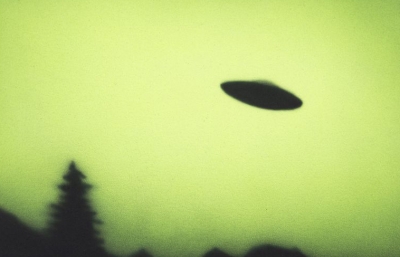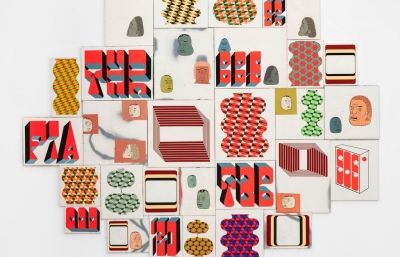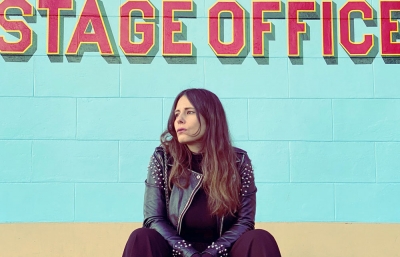MADSAKI
Homecoming King
Interview by Evan Pricco // Portrait by Chris Rudz
Subversive is a descriptive often overused in the art world, routinely referencing a brand of humor or political message, sometimes both, resulting in my hesitancy to use the term even when it's most apt. In MADSAKI’s work, though, I can’t help but feel the fascinating, overwhelming, pulse of subversion. What we see as messy, sloppy, and often caustic, is a beautiful and telling story of belonging and nostalgia told in a brutally honest conversation of what it means to be an outsider.
When the Osaka-born, Jersey-raised and Tokyo-based MADSAKI first garnered attention for his art, it was through his Wannabie’s series, a collection of graffiti-like interpretations of the classics we commonly perceive as important works of centuries past. What made that series subversive is how it begged the question, “why?” Why are these things important? Why do cultures identify particular images as distinctly representational? Who decides? And what made the work so compellingly personal is that MADSAKI was in the process of figuring it all out for himself too.
It’s funny, though, that my clearest understanding of MADSAKI’s career came in the form of He-Man. When the artist began to dig deeper into the American pop-culture psyche, thrusting his own experiences of growing up in a culture that often presents barriers of entry, there was a breakthrough—and subversive—introspection of how we treat those around us. What does it feel like to be included? Or in this case, not included.
This spring, MADSAKI will return to NYC with Hello Darkness, My Old Friend (I’ve come to talk with you again) at Perrotin Gallery, his first solo show in Manhattan, years after living in the city before returning to Japan. In our conversation, MADSAKI draws a precise picture of the larger theme of America’s long, tumultuous relationship with immigration, a blurred line of humor and pain and a navigation of our memories of past trauma and triumph.

Evan Pricco: I would imagine that the lockdown of the past year affected you in some way, but I’m getting the sense it wasn’t much different than your normal day-to-day life?
MADSAKI: I was all chill. To me, lockdown or whatever, it didn't matter. It's just the same thing. I was already in lockdown for the past four years in my studio. Maybe I had the kids running around more? Basically, nothing’s changed for me, man. It's just so weird.
I had this epiphany recently about your work, that somehow you were able to incorporate the toys of our childhood into your artwork and all of a sudden, boom, everything felt more serious. Does that make sense? It was like all of the things that you had been trying to talk about with your work in many different ways, like the separation between you and feeling at home anywhere, this dichotomy of being both Japanese and American and neither at the same time.
You just fucking wrapped everything up for me.
Ha ha, well, the last time we sat down together, in 2019 at Beyond the Streets, you had spent the day “on assignment” in New Jersey where you grew up, sort of looking at inspiration from your childhood that could maybe make it into the work, right? What was that like?
I thought I was going to cry, but didn't. I was like, "Oh, my god. I can't believe I was living here for all my life." Not my life, but all my teenage years from elementary school to middle school, to high school. And I thought I was going to get a flashback or get OD'd by the memories, and it was just too weird, man. That town is so small, and it's changed—but it didn't change at all! Manhattan changes, you get the new buildings, but that town hasn't changed at all. It was like, "Wow." It was kind of eerie.

It was a different perception when you were younger?
I learned that word "suburbs" when I went to college. Oh, I was living in the suburbs. Oh, that's the word. Okay. So the suburbs, that’s what I started painting. Since I was painting all that from my memory, I kind of miss it, but at the same time, I don't. And it was the same feeling when I went there two years ago to New Jersey. It was like, okay, I miss this so much and now I'm here, but I get that feeling I don't belong here or I never belonged here.
So what that does is force you to rethink your childhood, because you realize, "Oh, I knew I didn't fit in back then. But now I really know I didn't fit in."
Now I'm convinced that I never belonged there. I was trying to, subconsciously or consciously, belong and at least have fun. I think I was having fun, but it wasn't natural. It didn't feel natural. And going back as an adult, it still didn't feel natural.
In thinking about the Wannabie series, for those of us who didn't grow up around art history or art culture, you wonder about relationships with these classic paintings. There’s a sort of internal clash that could be messy. But when you start tapping into childhood and personal things, does anything change in your relationship to painting?
Mentally, it was totally different. But I do remember something, when I was baked from doing all the He-Mans over the last few years, I thought, “Okay, I can’t do this any more. I need a break.” And I took maybe two weeks off. I went back to the studio and I had to motivate myself. I was like, “Okay. I’ve got to get going.” And it was during this pandemic, and I thought, “All right. I’ve got to do the 9/11 painting first.” I had been waiting to do that painting for a long time. It's been inside of me for so long. So I did my 9/11, me sitting on my bike on the East River with the Twin Towers burning in the background. I had to feel ready for it.
So that's the beginning of this series?
But I still didn't see the whole picture, so I just kept going. What are the memories of my time in Jersey, in NY? And it was just like connecting the dots. When I did maybe five or six, I started seeing the whole picture. Speaking with Perrotin and Takashi, there wasn’t some big plan of what this NYC show was going to be, so I had to go through this process of just jumping into what I had in my memory bank.

So what did He-Man teach you?
Besides English?
Goddamn, that's perfect. So I’m right, it was a serious artistic move.
Because when you’re a kid, you turn on the TV, and you see He-Man. I didn't speak English or anything, so it was just the colors of He-Man in comics and cartoons, the colors and everything. He-Man, in particular, was just so different from what I saw in Japan, all the anime, until I was about six years old. American cartoons were just a totally different thing, and that caught my eye, this muscular, blonde dude. I didn’t know what he's saying, but it was good. He was sitting on a green tiger or lion, or whatever it was. And so, I just kept on watching. I didn't know what it was, but after a year or so, I was able to speak English like He-Man.
As you have gone back to revisit these memories, have you asked your parents for some sort of “adult” context as to what was going on then? Because they also had to upend their lives, moving to New Jersey with young kids.
Last year when I did the He-Man show and brought my parents, there was a painting of me, this third grade class photo painting. They started crying in front of the painting! And they told me, "We're very sorry that you had to go through what you had to go through." I was, like, what are you talking about? And they said, “Because I know your life must have been really harsh growing up in Jersey, not speaking the language.”
Art, drawing in particular, was how you connected with other kids in school, right? And I assume these toys were similar to?
Common ground… He-Man. That big sculpture I made of He-Man? We all had those toys, and they were something to communicate with. But you know what’s funny? I think second or third grade, I knew what kids were saying, just listening; but I couldn't speak. Around maybe late third grade, I woke up in the morning—woke up and all of a sudden, this English just started pouring out.

So TV was your teacher?
Yeah, because that's the only thing I did, watch MTV 24/7, watch cartoons, Scooby-Doo, everything that was playing on TV back then. My parents were like, "You were always, always watching TV." And I told them a couple of months ago, "But that TV was what helped me." Everything I saw is now coming out as an artwork these days.
It wasn’t like the typical American experience of zoning out in front of the tube, was it?
The theme of my life, I never... It's about belonging. I never belonged anywhere. And I'm always observing shit. I'm there, but I'm not truly in there, just looking, observing everything. My life was a lot like that, and TV is like, you're sitting in front of the screen, you're just observing. And I think that became my foundation for everything.
How much of you do you feel is American and how much is Japanese?
I think it's more American. My imagination is like 95% American, I’d say… And culturally too. The manner part, the mannerisms are the only part that feel Japanese.
So, what do Japanese audiences think of the art you make?
Oh, the funny thing is, Evan… on Instagram I have 100k followers, right? I think only three or four are Japanese followers.
[Laughs] Oh man. So what do your Japanese friends think? Or what about Takashi?
Takashi will say, "When I start talking to you, I realize that you're not Japanese. You're speaking Japanese, but you're not Japanese."

Let’s go back in time to when you moved to the States in 1980. In the context of what New York City was at the time, graffiti, hip hop, all that kind of culture, do you feel like it was a good time as a kid?
Definitely. If I wasn't living in that age, in that place, I don't think I would be doing what I'm doing right now. The 1980s and ’90s made me who I am today. Yeah, definitely.
The early 1990s, especially when I was going to art school, was amazing because the grunge scene was happening. But before that, it was this fully underground scene. I wanted to do music, but to do that, I had to be in a band, which I'm not really good at. I'd rather be alone. So there were only two choices: to become a musician or artist, and I picked artist.
My parents told me that after high school, I was going back to Japan for college. And I said, "Fuck no. I can't do that." When they asked me, as a senior in high school, what I was going to do, I thought, "I'm going to go to art school."
Name out of a hat!
So I went to my art teacher in high school and said, "Yo, I want to go to art school.” and she goes, "You need a portfolio." I was like, "What's a portfolio?" So I started making the portfolio. It wasn't really, "I want to be an artist”, but I just didn't want to go back to Japan. And I didn't want to study either.
But there had to be something that triggered you, not just some random thing.
I think it was when I first saw the Basquiat retrospective at the Whitney.
Bingo! Now we got it.
That must have been 1992, ’93? That just fucking blew my mind because I never knew about Basquiat.
Did you know anything about graffiti at all at that point?
No. I'd seen graffiti in the city, but I didn't have any artist friends who did art at all in high school. And I was the only one who was drawing and painting. Even though I went to Parsons, I didn't know anything about art. I did have one professor who taught me about outsider art, so I got into that, which brought me to Basquiat. Doors started opening right after that.
So these things that we’re talking about right now, have they been running through your mind while working on projects the last couple years?
No! [Laughs] I’m thinking it now because you asked me.

Love it—so what have you been thinking about?
I'm just being brutally honest with myself. And I think that is something Takashi has helped with. He taught me what art is for the past four years, so I just started digging into myself. Opened up the traumas, one by one. And I think that fucking led me here. I knew I had it, but I didn't know I could express it.
Last time you were in the magazine, we titled the interview the “Stupid Serious” or something like that. But it's funny to me that I actually think about your work right now as being very, very serious.
For real?
Yeah, man, this is a deeply personal look at belonging, what we do to belong when we feel like outsiders. What may look like He-Man, might be a cute painting of yourself in third grade in North Jersey, but there are new, layered applications and… it’s all very moving. Here in America, especially after the difficult four years and people being made to feel like they don’t belong, it’s important to talk about it.
You said it exactly right. Exactly. Because I was thinking the same thing. I was laughing alone in my studio, "What the fuck am I doing?” But like I was saying, each painting I finished by starting to create a wider picture. And it was the right work to be doing.
Let’s be honest, you have had tremendous success, career-wise, since the last time we spoke in the mag. Has it changed anything for you in terms of making art?
I don't know what the rest of the world thinks, so, no. I’ve never thought about it that way. Maybe for like two seconds, but…
What about those two seconds?
I think once, at a gallery opening, I had a feeling of finally making it. And that felt really good. I thought, "Hey, I get to make another show. And that's cool."

What does Japan mean to your work now?
It's funny because every time I go to LA, New York or Hawaii, there’s no inspiration making me want to paint. But if I come back to Tokyo, I'm like, "Okay, let's paint." Japan is the only country that makes me want to paint.
Why do you think that is?
I still haven’t figured it out.
Do you pay attention to a lot of what’s going on in the art world?
Tunnel vision, it’s my own fucking world. It's not like I'm not interested. I'm here, but I'm not here. I think it goes back to all the questions you asked me. It's like everywhere I go, I still don't feel I belong.
So what does the Perrotin show tackle? What memories?
It’s 1980–2004. When I did the He-Man show, I had paintings of Sesame Street and McDonald's, those things that opened a new door for me, places I could explore. That sort of gave me confidence to go a bit further, tap into childhood, my time in America, maybe create something a bit more personal.
Do you consider a show in NY as a homecoming show?
I was thinking about that too, man. New York, capital of the arts. So it's kind of scary to go there as an artist to show my paintings. But, yes, I’m going back. I'm going home. I feel like going home. Finally.
MADSAKI’s solo show, Hello Darkness, My Old Friend (I’ve come to talk with you again), will be on view at Perrotin in NYC through June 5, 2021

